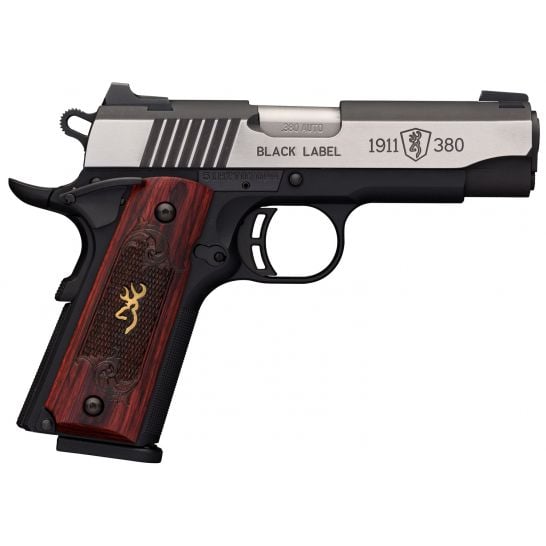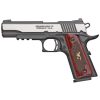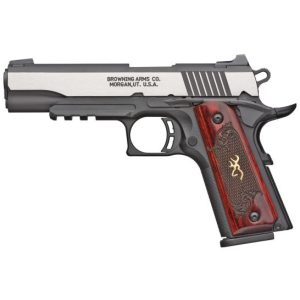Browning 1911-380 Black Label Medallion Pro Compact 380 ACP 8 Round Pistol, Black – 051915492 For Sale
$949.99
The Browning 1911-380 Black Label Medallion Pro Compact 380 ACP 8 Round Pistol in Black (Model 051915492) is a stylish and functional firearm that enhances the classic 1911-380 design with a touch of elegance. Its compact build is ideal for precise shooting and convenient carrying, featuring a composite frame with a machined aluminum subframe and a sleek blackened stainless steel finish with silver polished accents. The pistol’s visual allure is further elevated by checkered rosewood grips adorned with gold Buckmark logos. Equipped with steel three-dot combat sights seamlessly integrated into the slide, this pistol combines aesthetic appeal with practical precision, making it an ideal choice for enthusiasts who value both form and function.
Is the Browning 1911-380 discontinued?
Yes, the Browning 1911-380 is discontinued.
How many rounds does a Browning 1911-380 hold?
The Browning 1911-380 typically holds 8 rounds in its magazine.
Where is the Browning 1911-380 made?
The Browning 1911-380 is manufactured in Gurnee, Illinois, United States.
How big is the Browning 1911 Black Label 380?
The Browning 1911 Black Label .380 has a barrel length of 4.25 inches and an overall length of about 7.5 inches. It weighs approximately 17.5 ounces, making it a compact and lightweight pistol.
Why was the 1911 phased out?
The M1911 pistol was phased out primarily due to advancements in firearm technology and the evolving needs of military forces. Introduced in 1911, it served as the standard-issue sidearm for the United States Armed Forces for several decades. However, by the late 20th century, several factors contributed to its replacement:
1. **Capacity**: The M1911 has a single-stack magazine, limiting its capacity to 7 or 8 rounds of .45 ACP. Modern military doctrines often favor higher-capacity, double-stack magazines.
2. **Weight and Size**: The M1911 is relatively heavy and larger compared to newer designs, which can be cumbersome for soldiers carrying a plethora of gear.
3. **Maintenance**: While reliable, the M1911 requires more frequent maintenance and skilled armorer support to keep it in optimal working condition, as opposed to newer models which can be easier to maintain.
4. **Global Standardization**: NATO standardization led the U.S. to adopt the Beretta M9 in the mid-1980s. The M9 uses the 9mm NATO round, which is more widely used among NATO forces than the .45 ACP.
5. **Modern Ergonomics and Features**: Newer pistols offer improved ergonomics, more safety features, and the ability to easily incorporate attachments like lights and optics.
The Beretta M9 officially replaced the M1911 in 1985, although the M1911 continues to see use in specialized military units and remains popular in civilian markets due to its historical significance and performance.
Is 380 obsolete?
The term “380” could refer to many things, such as a model number, area code, or some other designation. Could you please provide more context or specify what “380” is referring to? This will help me provide a more accurate answer.
How many rounds does it take to break in a 1911?
Breaking in a 1911 pistol typically takes about 500 to 1,000 rounds. This process ensures that all the parts are properly seated and functioning smoothly together. However, it’s always a good idea to refer to the manufacturer’s guidelines for specific recommendations regarding the break-in procedure for your particular model.
What ammo does a Browning 380 use?
The Browning .380 typically uses .380 ACP (Automatic Colt Pistol) ammunition.
What is the trigger pull weight on a Browning 1911 380?
The trigger pull weight on a Browning 1911-380 is typically around 4.5 to 6 pounds.
Who makes Browning guns now?
Browning guns are currently manufactured by the Browning Arms Company, which is owned by the Belgian firearms manufacturer FN Herstal.
Who makes ammo for Browning?
Browning ammunition is produced under a partnership with Winchester, which is part of the Olin Corporation. Winchester manufactures and distributes ammo under the Browning brand.
Are Winchester and Browning the same company?
No, Winchester and Browning are not the same company. Winchester is a brand with a history dating back to the Winchester Repeating Arms Company, whereas Browning is a company founded by John Browning, a renowned firearms designer. Although they have had collaborations in the past, especially during the early 20th century, they remain separate entities.
Do they make a 1911 in 380?
Yes, some manufacturers do make a 1911-style pistol chambered in .380 ACP. One notable example is the Browning 1911-380, which is a scaled-down version of the classic 1911, designed specifically to chamber the .380 ACP cartridge.
When was the Browning BDA 380 made?
The Browning BDA 380 was manufactured from 1977 to 1997.
Why is there a 380 ammo shortage?
The shortage of .380 ammo can be attributed to several factors:
1. **Increased Demand:** A rise in gun ownership and concealed carry permits often leads to increased demand for popular calibers like .380 ACP, commonly used in compact and subcompact handguns.
2. **Production Constraints:** Firearms and ammunition manufacturers may face production limitations due to supply chain disruptions, labor shortages, or prioritization of more popular calibers such as 9mm.
3. **Stockpiling:** During periods of uncertainty or potential regulatory changes, consumers tend to purchase and stockpile ammunition, further contributing to shortages.
4. **Market Dynamics:** Shifts in market focus or changes in law enforcement or military contracts can also impact the availability of certain ammo types.
These factors combined can lead to a scarcity of .380 ammunition on the market.
| Product Line | 1911-380 Black Label Medallion Pro Compact |
|---|---|
| Action | Single |
| Magazine Type | Single Stack |
| Sights | Night Sight Dot Front, Night Sight Bar Rear |
| Sight Radius | 4-3/4" |
| Slide | Black Stainless Steel |
| Safety | Ambidextrous Manual |
| Grips | Rosewood with Gold Buckmark Inlay |
| Barrel Material | Steel |
| Receiver Material | Composite |
| Frame Material | Polymer/Aluminum |
| Barrel Finish | Matte |
| Receiver Finish | Matte Black |
| Frame Finish | Black |
| Overall Length | 6-7/8" |
| Checkering | Molded |
| Trigger Material | Alloy |
| Trigger Finish | Matte Black |
| Trigger Guard Material | Composite |
| Trigger Guard Finish | Matte Black |
| Case | ABS |
| Barrel Type | Target Crown |
Be the first to review “Browning 1911-380 Black Label Medallion Pro Compact 380 ACP 8 Round Pistol, Black – 051915492” Cancel reply
Related products
Browning 1911-380 Black Label Medallion Pro Compact
Browning .380 ACP 1911 Pistol, 3.63" Barrel, White 3 Dot Sights, Black, Silver – 51970492



Reviews
There are no reviews yet.